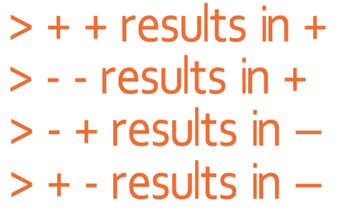Back to Edexcel Number (F) Home
1.1 L) Subtracting & Adding Negative Numbers
1.1 L) Subtracting & Adding Negative Numbers
Here are the rules when two signs are next to one another:
From these rules, we can see that two signs of the same result in addition; this is the case for + + and - -. Also, opposite signs result in subtraction; this was the case for - + and + -.
Let’s have a few examples.
Let’s have a few examples.
Example 1
Complete the calculation:
Complete the calculation:
We are taking away a negative number, which means that we are adding 3.
The answer to this question is 11.
Example 2
Complete the calculation:
Complete the calculation:
We are adding a negative number. Opposite signs result in a negative sign. The calculation becomes:
The answer is 15.
Example 3
Complete the calculation:
Complete the calculation:
We are adding a positive and we know that signs that are the same become a positive. Therefore, the calculation becomes:
Therefore, the answer to this question is 78.
Example 4
Complete the calculation:
Complete the calculation:
We are taking a positive and as the signs are opposite, it results in a negative. The calculation is:
The start number is a negative (-24). Therefore, it is probably best to sketch a quick number line with -24 on it. My sketch is given below.
We are taking 4 away, which means that we are moving 4 towards the left.
The answer for this calculation is -28.
End Note
The key rules to remember from this section is that:
It is worth getting these rules down on a revision card.
The key rules to remember from this section is that:
- Two of the same signs result in addition; this is the case for + + and - -
- Opposite signs result in subtraction; this was the case for - + and + -
It is worth getting these rules down on a revision card.











